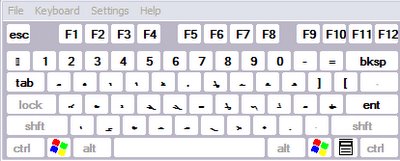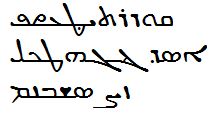Syriac Keyboards
 I thought that I would try out the Syriac keyboards tonight. There are two. The first one is not romanized and does not relate to any other keyboard I know.
I thought that I would try out the Syriac keyboards tonight. There are two. The first one is not romanized and does not relate to any other keyboard I know. I tried out the second one. It is called a 'phonetic' keyboard which seems to mean, in this case, a romanized keyboard. It matches the QWERTY keyboard as much as possible.
I tried out the second one. It is called a 'phonetic' keyboard which seems to mean, in this case, a romanized keyboard. It matches the QWERTY keyboard as much as possible.However, take a good look at these keyboards - these images are close to life size. Now I have to say that I have tried onscreen keyboards from lots of different developers and they are all the same in this respect - they are completely unreadable by anyone over 40 and by many children.
Frankly, it is somewhat reassuring for me to know that I have this onscreen keyboard in the accessibility options, as long as I don't actually intend to use it.
Next step. I opened Wordpad and set it for Estrangelo Edessa font size 26. Then I keyed in the letters across the QWERTY keyboard with this result. Beautiful. It was a keeper.

Nowever, I had one more step to complete. I switched to BabelPad and keyed in the same sequence then I clicked on u ̈ and produced the second image.
 In this display the letters are in their 'logical' left to right order. Using right to left is no big deal for me since I have studied Hebrew ... once upon a time ... but if I work in logical order then the cursor goes with me and not against me. That makes it worth considering. The major advantage is that I now have the independent forms not the connected ones.
In this display the letters are in their 'logical' left to right order. Using right to left is no big deal for me since I have studied Hebrew ... once upon a time ... but if I work in logical order then the cursor goes with me and not against me. That makes it worth considering. The major advantage is that I now have the independent forms not the connected ones.Now, if only I knew some Syriac to type. I have found the image from yesterday's post and type in the wordlist. (Minus the two words which have letters that are too small for me to decipher.)
ܛܘܪܐ - turā mountain
ܡܕܝܬܐ - mdittā city
ܡܠܟܐ - malkā king
ܡܠܟܬܐ - malktā queen
ܥܡܐ - ʿammā people
ܟܬܒ - ktab to write
ܢܦܠ - npal to fall
ܥܪܩ - ʿraq to flee
ܫܡܥ - šmaʿ to hear
Syriac is absolutely beautiful and keying it in was a dream. Learning more Syriac actually seems possible. I don't have any unusual abilities in the area of visual memory so there are only a few scripts that I am truly comfortable with. I hope that Syriac will become one of those. I was pleasantly surprised by all the books on Syriac available from Amazon. Neat.
I did notice, however, that there were extra symbols, superscripts or diacritics in the text of the Syriac (Jacobite) script version of the Little Prince. I have no idea what they are. Vowels I would guess, but I don't really know.
The only difficulty I had with this post was that there is no SMALL LETTER T WITH DOT BELOW in the Lucida Sans Unicode Font, which is where I found the left half ring. A problem for another day.
4 Comments:
Can you use the Unicode character U+0323, which is called the COMBINING DOT BELOW? It's not always placed quite correctly below, which is a problem with all combining characters using certain fonts, more or less.
Anyhow, it looks like this with a t:
ṭ
By comparing the Syriac and Latin versions, and referring to the Omniglot page, I've managed to render the first sentence of Malcuno Zcuro in Unicode. There are probably some errors - I don't really know anything about Syriac spelling, and there are a lot of diacritics that basically look like a dot. Also the editor I was using didn't render the text quite perfectly in some cases, leaving me uncertain as to the correct order. But it should be mostly correct.
ܥܶܡܪܺܝ ܫܶܬ݂ ܐܷܫܢܶܐ ܚܙܶܐ ܗ݇ܘܰܝܠܺܝ ܢܰܩܠܰܐ ܒܶܟܬ݂ܳܘܳܐ ܕܥܰܠ ܗ݇ܘ݂ ܥܳܒܳܐ ܒܬ݂ܽܘܠܳܐ ܕܟܶܬܘܰܐ ܐܷܫܡܶܗ »ܫܰܪ̈ܒܶܐ ܕܰܐܬ݂ܶܢ ܒܪܺܝܫܶܗ-ܕܚܰܕ݇« ܨܽܘܪܬܳܐ ܗܕ݂ܺܝܪܳܬܐ.
Cəmri šeṯ əšne ḥzewayli naqla bkṯowo dcal u cobo-bṯulo dkətwa əšme »Šarbe daṯən briše-dḥa« ṣurto hḏirto.
If you want to see it in a form more closely resembling the original, the Beth Mardutho fonts include several Serto variants. You can see samples on the Syriac page of David McCreedy's Gallery of Unicode Fonts. (Incidentally, Estrangelo Edessa, in Windows, is actually one of the fonts from this package.)
Thanks Tim,
I will post again on Syriac at least once more soon.
I think I've worked out what's going on with the left and right half rings in Estrangelo Edessa and the other Beth Mardutho fonts - they actually do all contain glyphs for U+02BE and 02BF, but they've been mistakenly encoded at U+02D2 and 02D3 (similar-looking characters, which shouldn't actually be superscript). At least, that's how it looks to me.
Post a Comment
<< Home